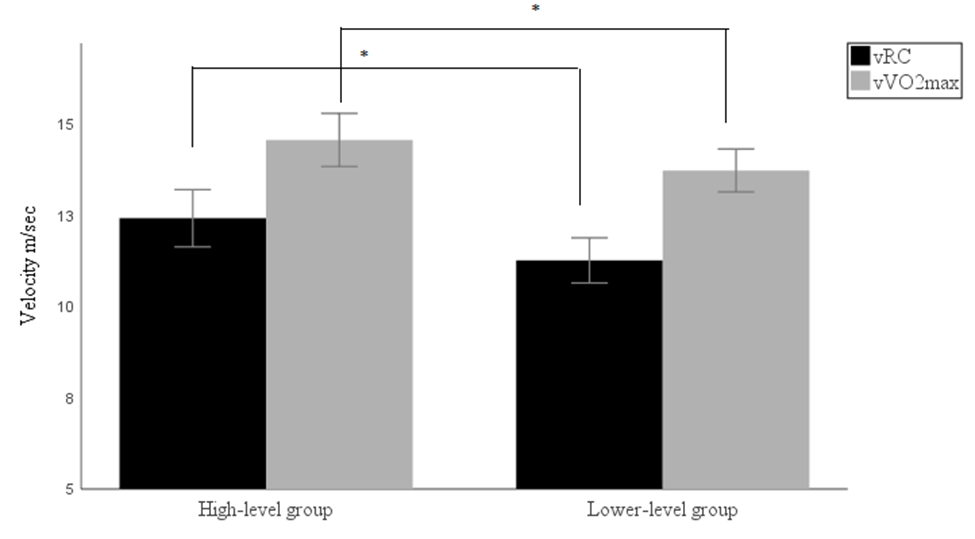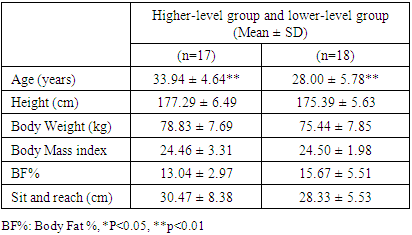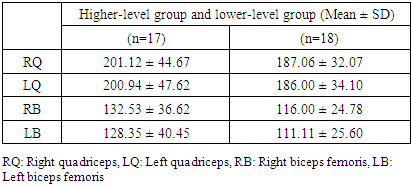-
Paper Information
- Previous Paper
- Paper Submission
-
Journal Information
- About This Journal
- Editorial Board
- Current Issue
- Archive
- Author Guidelines
- Contact Us
International Journal of Sports Science
p-ISSN: 2169-8759 e-ISSN: 2169-8791
2022; 12(1): 8-13
doi:10.5923/j.sports.20221201.02
Received: Jan. 11, 2022; Accepted: Jan. 24, 2022; Published: Jan. 27, 2022

Anthropometric, Strength, and Aerobic Fitness of Higher and Lower-Level Soccer Referees
Koulla Parpa, Marcos Michaelides
Department of Sports Science, UCLan University of Cyprus, Pyla, Cyprus
Correspondence to: Koulla Parpa, Department of Sports Science, UCLan University of Cyprus, Pyla, Cyprus.
| Email: |  |
Copyright © 2022 The Author(s). Published by Scientific & Academic Publishing.
This work is licensed under the Creative Commons Attribution International License (CC BY).
http://creativecommons.org/licenses/by/4.0/

Soccer refereeing is a challenging task that entails dealing with high physical, physiological, and cognitive demands. This study aimed to examine the anthropometric, strength, and aerobic fitness of higher and lower-level soccer referees in Eastern Europe. Body composition, aerobic fitness, and lower body strength were assessed for seventeen higher-level (age: 33.94±4.64 years, height: 177 ± 6.49cm, weight: 78.83±7.69kg) and eighteen lower-level referees (age: 28.00±5.78 years, height: 175.39± 5.63cm, weight: 75.44±7.85kg). It was demonstrated that the higher-level referees are older [t(33) = 3.34, p = .002] and have significantly better aerobic fitness than lower-level referees. More specifically, they demonstrated greater running times [t(33) = 2.50, p = 0.018, d= 0.85] and VO2max [t(33) = 2.99, p = 0.005, d=1.02]. In addition, the velocity at respiratory threshold and the velocity at VO2max was significantly greater in the higher-level group than the lower-level group [VRC: t(33) = 2.46, p = 0.019, d= 0.83, VVO2max:t(33) = 1.91, p = 0.06, d= 0.64] Concurrently, no significant differences were identified with regard to body composition, lower body strength, and flexibility. The results could be useful to the referees themselves, their fitness coaches, and instructors as they can be used to improve their performance and potentially their professional development. Referees aiming to achieve higher officiating levels need to achieve high aerobic fitness as elite soccer is intense and requires high aerobic fitness. Concurrently, older referees need to maintain optimal body composition and aerobic fitness as both tend to be compromised with aging.
Keywords: Age, Body Fat, Isokinetic Testing, VO2max
Cite this paper: Koulla Parpa, Marcos Michaelides, Anthropometric, Strength, and Aerobic Fitness of Higher and Lower-Level Soccer Referees, International Journal of Sports Science, Vol. 12 No. 1, 2022, pp. 8-13. doi: 10.5923/j.sports.20221201.02.
Article Outline
1. Introduction
- Soccer refereeing is a challenging task that entails dealing with high physical, physiological, and cognitive demands [1,2]. In their endeavor to manage soccer games impartially and be in the right position to judge the players' actions, referees are required to keep up with the play at all times and reach quick decisions despite being supported by the assistant referees, the fourth official, and the video assistant referee (VAR) [1,2,3]. Given that soccer referees play an integral part in professional games, and their performance has an inevitable influence on game outcomes, there is a clear need for an appropriate fitness level that they need to maintain. Research has shown that soccer referees experience physical demands similar to those of professional soccer players and more specifically, midfielders [4]. For example, studies indicate that a referee may cover an average distance of 9km to 13km during a competitive game, out of which 4-18% is performed at high intensities or speeds between 13 to 18km/h [5]. Concurrently, it has been indicated that their ability to perform high-intensity running is reduced towards the end of the games [6], which is parallel to what is reported for soccer players [7]. Additionally, their heart rate values range between 85 and 90% of their maximum heart rate during competitive games, while the maximal oxygen uptake (VO2max) ranges between 70 and 80% of their maximum. Furthermore, during games, research demonstrated a pronounced contribution of the aerobic energy system and a considerable stimulation of the anaerobic energy system as indicated by the high blood lactate concentrations [6]. Conclusively, considering that elite players and referees run similar distances close to an anaerobic threshold, referees need to maintain a certain level of aerobic fitness in order to perform optimally during a 90-minute game. However, in contrast to elite players, most referees are not full-time professionals and usually engage in other occupations. Along with that, referees are older, have different body composition and aerobic capacity, and cannot be substituted during the games. Within the sports context, research indicated that soccer players participating at the highest level (Division 1) exhibit higher values for VO2max and longer total running time than the lower division players [8]. With regard to lower body strength, research also indicated that peak isokinetic torque of the knee joint is significantly higher in Division 1 players compared to those competing in Division 2 [9]. However, little scientific evidence is available on referees of different divisions who are often overlooked. So far, scientific interest is limited to some aspects of assistant and soccer referees' anthropometric [10] and performance characteristics based on age [11,12], whereas differences in anthropometric and performance characteristics between referees of different levels were not examined. Nevertheless, one study that compared top class and high standard referees indicated only a few significant differences in covered distances while no significant differences in mean heart rates and blood lactate values were identified between the two groups [6]. Lastly, one study indicated differences between lower-level and higher-level Spanish soccer field referees with respect to change in direction ability test performance, but not sprinting speeds [13]. There are currently different levels of referees, and their progression to a higher level of competition is determined by their time of experience, age, and performance in official games. Consequently, by the time they are officiating at an elite level, they are older, which may be associated with a decline in cardiorespiratory fitness [11]. On the other hand, the physical demands at division 1 soccer games are increased, and hence, there is a clear need for a proper fitness level of the referees. Therefore, this study aimed to examine the anthropometric, strength, and aerobic fitness of higher and lower-level soccer referees in Eastern Europe.
2. Methods
2.1. Participants
- This observational study included thirty-five referees divided into the higher-level (Division 1 referees, n=17) and the lower-level group (Divisions 2 and 3 and youth referees, n=18). All referees underwent a general clinical examination and obtained medical clearance before they registered for participation in the soccer championship. In addition, each referee was briefed on the procedures and signed an informed consent before entering the study. The study was performed in accordance with the Declaration of Helsinki and was approved by the University's ethics committee board and the National Committee on Bioethics. The tests were carried out for both groups prior to the beginning of the season, following the preseason preparation. Fitness testing was conducted on two different testing days to avoid potential fatigue from subsequent testing. Referees were advised to abstain from any activity the day before testing, and measurements were obtained between 8:00 am and 13:00.
2.2. Anthropometric Measurements
- Weight, body fat, and height were recorded prior to testing. A wall stadiometer (Leicester; Tanita, Tokyo, Japan) was used to measure the referees' stature, which was recorded to the nearest centimeter. Body composition was determined using a leg-to-leg bioelectrical impedance analyzer (BC418MA; Tanita). All referees were instructed to follow the standard BIA (bioelectrical impedance analysis) guidelines [14] before the measurements were obtained.
2.3. Sit And Reach Test
- A sit and reach box (32.4 cm high and 53.3 cm long) with a 23 cm heel line mark was used to assess the flexibility of the lower back and hamstring muscles. Players removed their shoes and placed the soles of their feet against the box while knees were fully extended. They were instructed to avoid fast and jerky movements while leaning forward with their hands on top of each other and palms facing downwards. The players performed two practice trials, and the 3rd trial was recorded to the nearest cm.
2.4. Cardiopulmonary Testing
- Cardiopulmonary testing (CPET) was performed to assess aerobic fitness using a maximal incremental test on a treadmill (Cosmos Quasar med hp, H-P-Cosmos Sports & Medical GmbH, Germany). The gas exchange measurements were collected on the Cosmed Quark CPET system (Rome, Italy), using a breath-by-breath analysis through reusable rubber masks. The device was calibrated as suggested by the manufacturer. The laboratory temperature was kept constant at 20 ± 2°C, and the relative humidity was 50%. The modified Heck incremental maximal protocol was used for the testing, as it was previously demonstrated to be valid and reliable on soccer players [15]. The test came to an end when the participant reached volitional fatigue or when there was no variation among the VO2 levels while the workload increased. The maximal oxygen uptake (VO2max) was detected after having the results filtered to identify the highest value for an average of 10 seconds.
2.5. Isokinetic Testing For Lower Body Strength
- The isokinetic torque of the knee was measured utilizing the Humac Norm and Rehabilitation system (CSMi Medical & Solution, MA, USA) to evaluate lower body strength. Referees performed a 10-min self-paced warm-up on a mechanically braked cycle ergometer (Monark 894 E Peak Bike, Weight Ergometer, Vansbro, Sweden) before the isokinetic testing. Once the participants were appropriately positioned on the isokinetic device, they performed five sub-maximal repetitions of concentric knee flexion and extension for familiarization. Testing included three maximal concentric flexion and extension repetitions at an angle speed of 60°/s.
2.6. Statistical Analysis
- SPSS 26.0 for Windows (SPSS Inc., Chicago) was used to analyze the results. Means and Standard Deviations were calculated for all the parameters. The Brown and Forsythe's and Shapiro-Wilk tests were used to assess the homogeneity of variance and normality assumptions. Means were compared using an independent -samples t-test. Cohen's d was utilized to determine the effect size. Effect sizes were interpreted as follows: small (0.2–0.4), medium (0.5–0.7), and large (0.8–1.4) [16]. For all statistical analyses, significance was accepted at p < 0.05.
3. Results
- Results indicated that even though the higher-level referees were significantly older t(33) = 3.34, p = 0.002, the anthropometric and body composition parameters (Table 1) were not significantly different between higher-level group (age: 33.94±4.64 years, height: 177 ± 6.49cm, weight: 78.83±7.69kg, BF%: 13.04± 2.97) and lower-level group (age: 28.00±5.78 years, height: 175.39± 5.63cm, weight: 75.44±7.85kg, BF%: 15.67± 5.51). Flexibility based on sit and reach test was also not significantly different between the two groups (Table 1). Furthermore, results demonstrated that higher-level and lower-level referees were not significantly different with regard to lower body strength assessed with isokinetic testing at 60°/sec (Table 2). On the contrary higher-level referees performed significantly better on the cardiovascular test and demonstrated significantly greater running times [t(33) = 2.50, p = 0.018, d= 0.85] and VO2max [t(33) = 2.99, p = 0.005, d=1.02] (Table 3). In addition, the velocity at respiratory threshold and the velocity at VO2max was significantly greater in the higher-level group than the lower-level group [VRC: t(33) = 2.46, p = 0.019, d= 0.83, VVO2max: t(33) = 1.91, p = 0.06, d= 0.64] (Table 3).
|
|
|
 | Figure 1. Velocity at respiratory threshold (VRC) and velocity at VO2max (VVO2max) |
4. Discussion
- The current study investigated the anthropometric, strength, and aerobic fitness of higher and lower-level soccer referees. The results of the study demonstrated that the higher-level referees are older and have significantly better aerobic fitness than lower-level referees. Concurrently, no significant differences were identified with regard to body composition, lower body strength, and flexibility.Regarding age, the higher-level referees were significantly older, and their average age was similar to the reported age of elite international referees [17], while the lower-lever group was significantly younger. Research indicated that long-term training might considerably correct perceptual deficiencies, which affect younger and less experienced referees. Consequently, age may contribute to the improved quality and adequacy of referees' decisions [17]. This was further supported by an investigation that demonstrated that even though older referees run shorter distances during the game, they make their decisions as close to the ball as the younger referees who run more [18]. That ability to remain close to the ball at all times could be attributed the years of experience. Therefore, considering that progression to a higher level of competition is determined by the referees' time of experience, age, and performance in official games, high-level referees are expected to be older than lower-level referees. Based on the anthropometric characteristics, the higher-level referees were on average taller than the lower-level referees as well as taller than South African referees with a mean height of 173.0+/-6.7cm [19]. Concurrently, higher-level referees had similar stature to the international refereeing populations [5,11,13]. Considering that the referees in the current sample had the same ethnicity, it can be assumed that higher-level referees are required to be taller as greater stature may provide more authority on the field and allow for a better view. Additionally, the mean body mass index for the participants in the current sample fell between the reported values that range between 23.6 kg.m2 and 27.1 kg.m2 determined for Brazilian [12,20], Swiss [21], Greek [22], European [1] and English [23] referees. Furthermore, body fat measurements indicated that body fat percentage was less in higher-level referees (13.04 ± 2.97) than the lower-level referees (15.67 ± 5.51), although the difference was not statistically significant. The body fat percentage varies in different countries, with the Spanish professional referees demonstrating the lowest percentages (11.3 ±2.15) [11] while the English professional referees are demonstrating greater values (18.9±3.7) [23]. The BF% of the referees in this study was greater than the average body fat of Spanish referees but lower than English professional referees. However, considering that the different methods utilized to assess body fat vary in their precision and accuracy, caution is needed when comparing results from different body fat assessment techniques. The VO2max results in this study were significantly better for higher than lower-level referees. Concurrently, higher-level referees demonstrated values greater than the expected VO2max based on their age. Therefore, the age-related decline of VO2max due to the reduction in cardiac output and reduced contractility that has been reported after the age of 25 years was not confirmed in our study [24]. Based on that, the Federation International of the Football Association (FIFA) should pay attention to the physical assessments of older referees rather than age alone. The VO2max values for the higher-level referees of the current study were similar to those identified for the Italian field [2] and English referees [25] but lower than those of Spanish [11] and Brazilian [20] referees. At the same time, the VO2max values of higher-level referees were higher than those reposted for top-class Danish referees [6]. In addition, performance, as determined by the total running time on the treadmill, was significantly greater for higher-level referees. Furthermore, the higher-level referees' velocities at respiratory compensation (VRC) and VO2max (VVO2max) were significantly greater. The VRC value reported in this study (12.42±1.53) was similar to the reported value for Brazilian referees (13.5 ± 1.1) while the VVO2max velocities were much lower (14.57±1.42 and 16.6 ± 1 for Cypriot and Brazilian referees, respectively) [12]. Running velocity attained at RC has been shown to be positively correlated with the distance covered during official games [26]. Although a major proportion of game time consists of running at low to moderate speeds, high-speed running and sprinting are essential to follow the game closely.
5. Conclusions
- Based on the results of this study, it can be concluded that the aerobic fitness status of the higher-level referees is superior to that of the lower-level referees. The differences in aerobic performance may be attributed to the training hours per week during preseason, in-season, or the number of games they officiate. Furthermore, the differences in aerobic performance may be attributed to the lower-level referees' lack of training structure and modality. It should be noted that although there was no significant difference in the lower body strength between the two groups, higher-level referees demonstrated greater torque values for both the hamstring and quadriceps muscle groups.
6. Recommendations
- The results of this study could be useful to the referees themselves, their fitness coaches, and instructors as they can be used to improve their performance and potentially their professional development. Referees aiming to achieve higher officiating levels need to achieve high aerobic fitness as elite soccer is intense and requires high aerobic fitness levels. Concurrently, older referees need to maintain optimal body composition and aerobic fitness as both tend to be compromised with aging. Based on our results, higher-level referees' body composition and performance were not negatively influenced by age, but instead, they exhibited better cardiovascular profile than the lower-level referees indicating an area in which lower-level referees could improve in order to aid their professional development. Finally, even from a psychological point of view, high fitness levels emphasize the ability to keep up with the game and may further help when asserting authority on the field.
 Abstract
Abstract Reference
Reference Full-Text PDF
Full-Text PDF Full-text HTML
Full-text HTML

